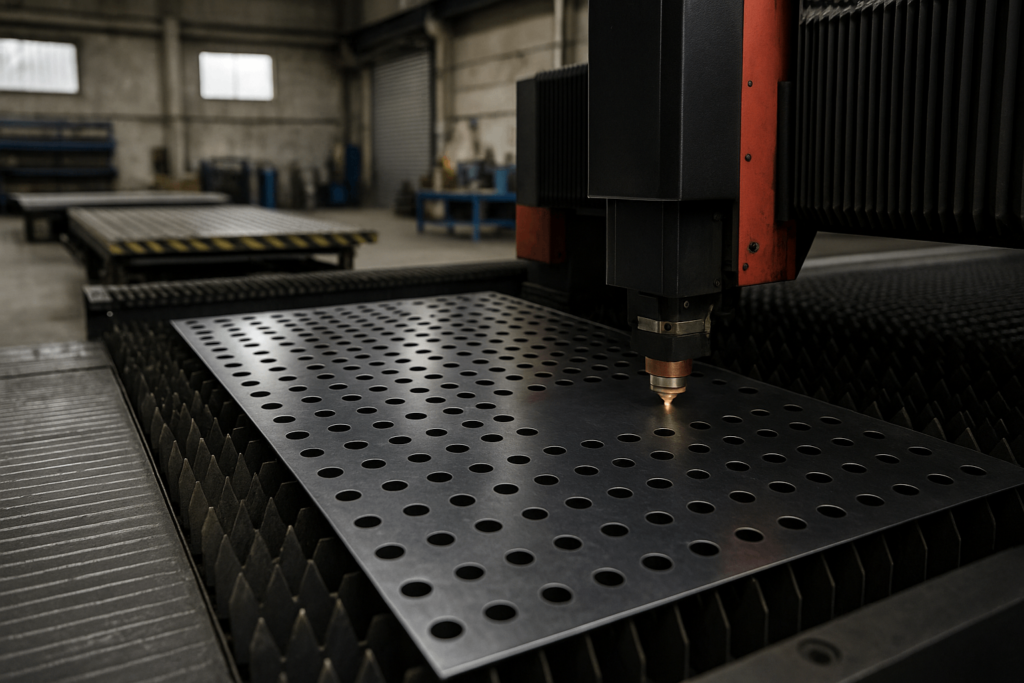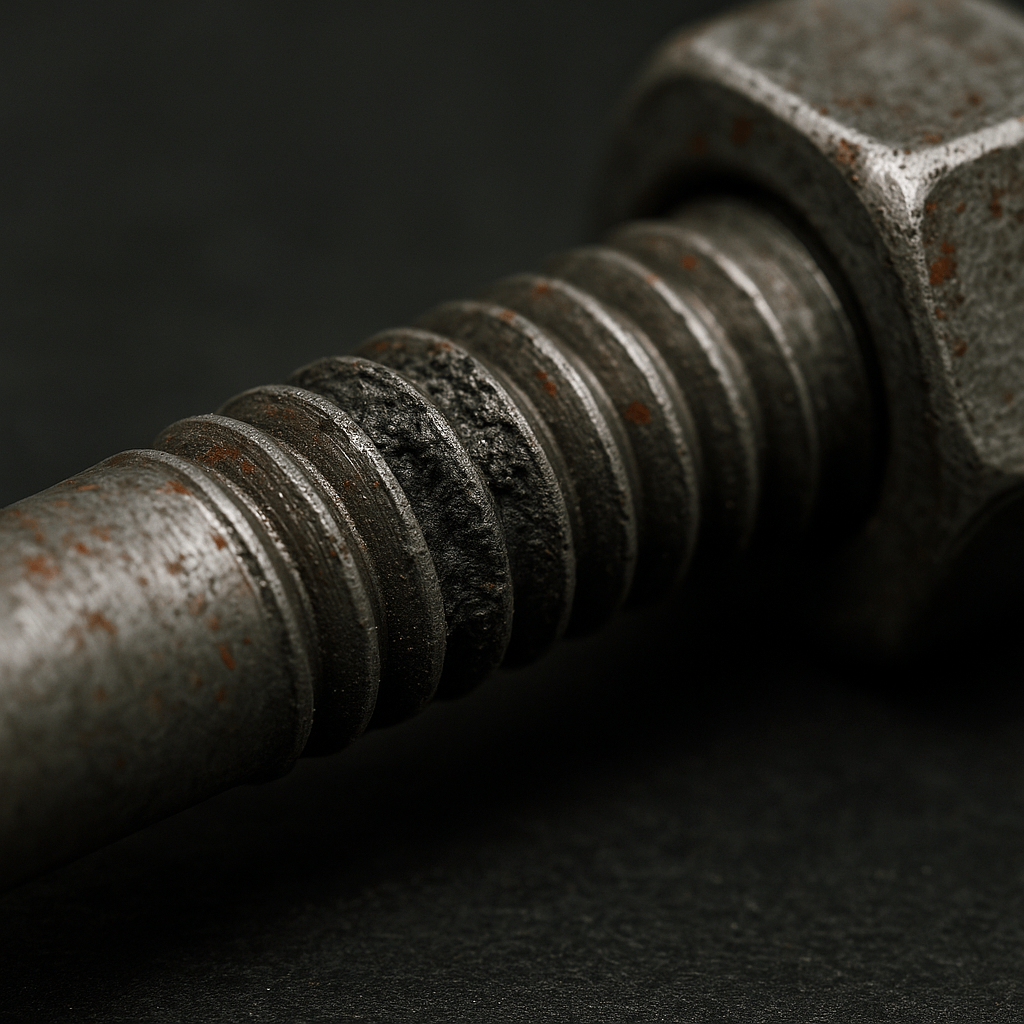What Is Fretting in Metal Parts?
Fretting is a surface damage process that occurs when two metal surfaces in contact experience small, repeated relative motion under load. These micro-slips cause wear, oxidation, and fatigue cracks at the interface — a condition often called fretting wear or fretting corrosion.
In practical engineering terms, fretting represents a microscopic but highly destructive failure mode that silently reduces component life in assemblies such as bearings, bolts, splines, and press-fits.
The Unseen Enemy: A Failure You Can't See, Until It's Too Late
In the world of engineered metal components, unexpected failure is the ultimate cost. A critical press-fit bearing begins to vibrate, leading to an unscheduled shutdown. A tightly bolted structural joint, designed to be static, loosens over time, compromising product integrity.
This phenomenon, technically known as fretting wear, differs from conventional frictional wear because the motion amplitude is extremely small — often less than a few micrometres.
These failures are often not caused by a sudden overload or a visible manufacturing defect. The root cause is often microscopic—a hidden tremor that silently degrades the integrity of the metal at the interface.
This subtle but destructive mechanism is known as fretting, a localized surface damage phenomenon that occurs at the contact area between two loaded materials subjected to minute, repetitive oscillatory motion.
Why Fretting Matters for Procurement and Reliability
The true danger of fretting lies in its ability to silently weaken structures. It can slash a material’s fatigue strength by more than 70%, turning otherwise sound components into early failure points.
For OEMs and wholesale buyers sourcing metal assemblies, understanding fretting is not optional—it’s a frontline concern. This failure mode directly impacts warranty costs, operational downtime, and long-term brand reputation.
From a reliability perspective, fretting is not merely surface discoloration — it’s an early stage of mechanical failure that propagates into cracks and fatigue fractures.
For engineers researching what causes fretting in metal parts, the answer lies in managing vibration, load, and surface chemistry.

The Crime Scene Investigation: Uncovering the Telltale Evidence of Fretting
Identifying fretting as the root cause of a failure requires a systematic, evidence-based investigation. The damage often leaves behind distinct visual and microscopic evidence that, when properly interpreted, points directly to this silent destroyer.
A thorough failure analysis is the first step toward applying the right and most cost-effective preventive measures to safeguard long-term performance.
The Smoking Gun: The "Cocoa Powder" Debris
The most iconic evidence of fretting on ferrous materials is the appearance of a fine, reddish-brown dust at the contact interface. This wear debris, often likened to cocoa powder, is a telltale sign of advanced fretting corrosion.
It’s important to note that this powder is not typical rust. It forms in dry conditions and is primarily composed of iron(III) oxide (hematite, Fe₂O₃). Fretted aluminum alloys often yield a black powder instead, making fretting corrosion in aluminum an identifiable but distinct failure signature.

Reading the Scars: Pits, Grooves, and False Brinelling
In addition to debris, the metal surfaces themselves show scars. Pitted or grooved textures often appear rough or chafed.
In rolling element bearings, fretting manifests as false brinelling—wear marks spaced at the interval of the rolling elements, caused by static vibration. These defects become stress risers, initiating fatigue once the bearing operates.
Under the Microscope: A Deeper Analysis
While visual inspection provides strong clues, a conclusive diagnosis often requires microscopic evaluation:
A Scanning Electron Microscope (SEM) examines surface topography, identifying crack initiation sites and supporting fretting fatigue testing.
With Energy-Dispersive X-ray Spectroscopy (EDS), SEM reveals elemental composition of the debris and signs of material transfer.
Surface profilometry quantifies wear geometry, measuring material loss and surface degradation.
Fretting in Action: Four Stories of Metal Failure
Understanding real-world cases of fretting failures reveals vulnerabilities in design and procurement that lead to costly breakdowns.
Story 1: The Aerospace Nightmare (Fretting Fatigue)
Jet engines rely on dovetail joints exposed to extreme vibration and thermal cycling. Micro-motion between titanium blades and the disk slot initiates fretting fatigue, a condition that limits service life. Cracks can propagate rapidly, showing the importance of fretting-resistant designs.
Story 2: The Automotive Anomaly (Fretting Wear in Bearings)
During rail shipment, wheel bearings in vehicles develop false brinelling due to low-amplitude vibration. With grease displaced, direct metal contact leads to fretting wear—causing failures before vehicles reach customers and increasing warranty returns.

Story 3: The Biomedical Betrayal (Fretting Corrosion in Implants)
Modular hip implants suffer from tribocorrosion due to micro-motion in a moist, reactive environment. Released metal ions trigger biological complications. This case underscores the need for surface integrity and biocompatibility.
Story 4: The Slow Grind (Wear Progressing into Fatigue)
An industrial gearbox’s splined coupling develops backlash from fretting wear in bolted joints. Over time, damage evolves into fretting fatigue, causing tooth fracture and total system failure. What begins as minor interface wear escalates into operational collapse.
Before addressing prevention, it’s crucial to understand the mechanical and environmental triggers behind fretting corrosion. Fretting corrosion describes the combined effect of micro-motion wear and oxidation, forming the characteristic reddish-brown “fretting debris.”
Root Causes of Fretting Wear in Metal Parts
Fretting emerges when four contributing factors align. Recognizing and managing these “ingredients” allows engineers to prevent it through better design and procurement specifications.
The Tremor (Relative Motion)
Slip amplitude determines the fretting regime:
Stick Regime: No relative motion—safe for static assemblies.
Partial Slip Regime: High stress, low wear—prime zone for fretting fatigue.
Gross Slip Regime: High wear and corrosion—less fatigue, but rapid material loss.
The Squeeze (Contact Pressure)
High normal loads increase real contact area and friction. While this can exacerbate wear, in some cases it helps eliminate motion by enforcing full stick.
The Arena (Materials & Surface Condition)
Material hardness, hardness ratio, and surface roughness all influence fretting behavior. Rough textures raise stress concentrations, though they may also help trap debris or retain lubricants. This is especially true for fretting in stainless steel, which responds differently under dry or lubricated conditions.
The Atmosphere (Environmental Factors)
Humidity, temperature, and exposure to oxygen or corrosive agents accelerate fretting. Fretting corrosion is often worst under intermediate humidity and moderate heat.
(A summary table of these four conditions remains available.)
While the physics of fretting are well understood, controlling it in production environments remains a major engineering challenge — especially in precision-machined metal parts used in aerospace, energy, and heavy-industry assemblies.
The 3 Levels of Defense: A Strategic Guide to Preventing Fretting
Preventing fretting requires eliminating movement, hardening contact areas, or controlling surface interaction.
Level 1: Design It Out (Eliminate Relative Motion)
The most effective strategy is to eliminate micro-motion entirely. This may include:
Increasing clamp force;
Specifying interference fits;
Adding vibration damping elements to assemblies.
Level 2: Armor the Surface (When Motion Is Inevitable)
When movement cannot be avoided, surface treatments protect against damage:
Shot peening induces compressive stress, resisting crack formation.
Anti-fretting coatings for bearings (e.g., TiN, Cu-Ni-In) enhance hardness or wear resistance.
Dry film lubricants reduce friction while avoiding dust or fluid buildup.
Level 3: Manage the Interface (Lubrication Strategy)
Lubricants designed to resist fretting can minimize wear. However, be mindful of the lubrication paradox: reducing friction may increase slip, worsening fretting fatigue in partial-slip conditions.
Conclusion: From Hidden Menace to Managed Risk
In essence, fretting is the hidden fatigue initiator that engineers often overlook. By the time visible damage appears, microscopic cracks have already propagated beneath the surface.
Fretting may be subtle, but it’s far from unpredictable. With proactive engineering and reliable suppliers, it can be anticipated and managed.
At YISHANG, our engineers work closely with global OEMs to identify failure risks and deliver robust, fretting-resistant solutions tailored to your application.
Need help solving a fretting issue? Looking to design it out from the start? Talk to our team today.
Frequently Asked Questions
How does fretting differ from general wear? Fretting arises from small oscillatory motion under load, while general wear involves continuous sliding. Fretting often traps debris and accelerates damage.
Why does fretting occur in metals? Metals exposed to vibration, preload, and cyclic loads create ideal conditions for fretting.
What role does surface roughness play? Rough surfaces amplify stress concentrations, though in some cases they help trap lubricants or debris.
Can design changes prevent fretting? Yes. Increasing clamp load, adjusting fit tolerances, and damping vibration can reduce or eliminate fretting.
How does fretting impact lifespan? Fretting introduces stress risers, initiating fatigue cracks. It can reduce component life by 50–70%.
What is fretting?
Fretting is the process where two metal surfaces under load experience very small oscillatory motion, causing wear, oxidation, and fatigue cracks. It’s most common in joints, bearings, and press-fits that appear static but move microscopically under vibration.

